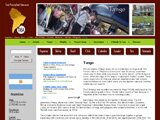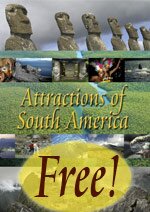Buenos Aires
Buenos Aires is a vibrant city full of life and passion. It emits more the feeling of a Southern European city which is no surprise as the roots of many "porteños" (citizens of the city) are from the "Old World".
There are many parks that make up for the busy streets. You can enjoy museums, restaurants, splendid monuments and, of course, tango-shows.
Buenos Aires Tours: See all our Argentina tours
 Tucan and Tango - SA36 Tucan and Tango - SA36TOUR TYPE: Small Group Tour TRAVEL TO: Argentina Uruguay - Brazil |
11 Days | Price and Tour Details |
 Journey to the Clouds - SA035 Journey to the Clouds - SA035TOUR TYPE: Small Group Tour TRAVEL TO: Argentina Uruguay - Brazil |
11 Days | Price and Tour Details |

City Highlights
Plaza de Mayo is the heart of Buenos Aires. There you'll find important landmarks such as the historical Cabildo (the city council during the colonial era), the Metropolitan Cathedral of Buenos Aires, the town hall and La Casa Rosada.
La Casa Rosada (The Pink House), officially known as the Palacio de Gobierno (Government Palace), is the official seat of the Executive Branch of the government of Argentina. Plaza de Mayo has been a silent witness of many emotional and heart-breaking moments in history.
Buenos Aires hosts many parks that provide a welcome escape from the busy streets. Parque 3 de Febrero, one of the biggest parks, begins in Palermo and runs northward to the city limits. In the surroundings you can find besides the zoo and a planetarium also some of the more interesting places to stop and relax: an Andalusian patio, a Danish rose garden and a Japanese pavilion with a lake. Several museums are in walking distance of the Parque 3 de Febrero.
Check out these wonderful budget hotels
and amazing hotels in Buenos Aires!

The landmark of Buenos Aires is without doubt the enormous Obelisk at the intersection of 9 de Julio and Corrientes avenues. The obelisk was built in May 1936 to commemorate the 400th anniversary of the founding of the city. It is located in the center of the Plaza de la República (Republic Square), the spot where the Argentinean flag was flown for the first time in Buenos Aires.
Its total height is 67 meters (219 ft.) and its base area is 49 square meters (54 yd.2). This area is also the place if shopping is an addiction that should be entertained. When you're out of "pesos" you can visit the house of author Jorge Luis Borges in the neighborhood.
Another option is the splendid pedestrian street Calle Florida for its boutiques and shopping malls but the mile long promenade is also a must for anyone interested in architecture. An itinerary that ends in leafy Plaza San Martín, named in honor of Argentina's national hero, passes banks, department stores and clubs built during the early years of the 20th century.
San Telmo, the oldest barrio (neighborhood) of Buenos Aires, originally housed the city's elite. When yellow fever struck in the 1870s -- aggravated by substandard conditions in the area -- the aristocrats moved north. Poor immigrants soon filled the neighborhood and the houses were converted to tenements, called conventillos. In 1970, the city passed regulations to restore some of San Telmo's architectural landmarks.
Today it's a colorful, semi-bohemian area dotted with antique shops, colonial architecture and many old churches (e.g., San Pedro Telmo). Some of the streets are still paved with the original cobblestones. The best time to visit is Sunday.
The Plaza Dorrego, the heart of the neighborhood, is then the scene of a flea market and the streets are filled with performers such as jugglers and tango dancers. Tango aficionados can find the oldest and best known tango cafes such as El Viejo Almacén, Michelangelo, La Casa Blanca and La Casa Rosada in San Telmo.
Check out these wonderful budget hotels and amazing hotels in Buenos Aires
The latest big development project has been Puerto Madero. It is lined with converted old red brick warehouses on the dock side. You can escape the city for awhile in the nearby Nature Reserve (Reserva Ecológica).
 La Boca is Buenos Aires most colorful barrio. It was built by Italian immigrants along the Riachuelo, a sinuous waterway lined with meat packing plants and warehouses.
La Boca is Buenos Aires most colorful barrio. It was built by Italian immigrants along the Riachuelo, a sinuous waterway lined with meat packing plants and warehouses.
"El Caminito", made famous by tango legend Carlos Gardel, is a must see when you travel in Argentina (even if you're not a tango aficionado).
The mystique of Eva Perón persists, more than 50 years after her death. The Peronist faithful still flock to her grave in La Recoleta Cemetery. Some years ago a new place of pilgrimage opened its doors: the Evita Museum which tells the story of her life and death and features memorabilia from her careers as actress and political idol.
Attractions of Buenos AiresLa Boca San Telmo Recoleta Cementerio de la Recoleta Palermo Viejo Teatro Colon Plaza Dorrego Calle Florida  Casa Rosada Puerto Madero Plaza de Mayo Plaza San Martin Museo Historico Nacional Museum of Latin America Art of Buenos AIres (MALBA) Catedral Metropolitana Museo Nacional de Bellas Artes Caminito Jardin Japonés La Confitería Ideal El Obelisco Biblioteca Nacional Academia Nacional de Tango Esquina Carlos Gardel Basilica y Convento de San Francisco Museo Evita |
Learn more about Buenos Aires here
----------
Other Must See Argentina Travel Places
| Ushuaia | Patagonia | Tango |
 |
 |
 |
Bariloche
Cordoba
Mar del Plata
La Plata
![]()
Food from Argentina
----------
----------
© Photograph "Two men in Buenos Aires" by Martin Vansteenkiste













